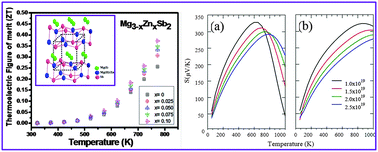Tuning the carrier concentration using Zintl chemistry in Mg3Sb2, and its implications for thermoelectric figure-of-merit†
Abstract
Zintl compounds are potential candidates for efficient thermoelectric materials, because typically they are small band gap semiconductors. In addition, such compounds allow fine tuning of the carrier concentration by chemical doping for the optimization of thermoelectric performance. Herein, such tunability is demonstrated in Mg3Sb2-based Zintl compounds via Zn2+ doping at the Mg2+ site of the anionic framework (Mg2Sb2)2−, in the series Mg3−xZnxSb2 (0 ≤ x ≤ 0.1). The materials have been successfully synthesized using the spark plasma sintering (SPS) technique. X-ray diffraction (XRD) analysis confirms a single solid solution phase of Mg3−xZnxSb2 (0 ≤ x ≤ 0.1). The thermoelectric properties are characterized by the Seebeck coefficient, electrical conductivity, and thermal conductivity measurements from 323 K to 773 K. Isoelectronic Zn substitution at the Mg site presents the controlled variation in the carrier concentration for optimizing the high power factor and reduced thermal conductivity. These results lead to a substantial increase in ZT of 0.37 at 773 K for a composition with x = 0.10 which is ∼42% higher than undoped Mg3Sb2. The electronic transport data for the Mg3−xZnxSb2 (0 ≤ x ≤ 0.1) compound are analyzed using a single parabolic band model predicting that Mg2.9Zn0.1Sb2 exhibits a near-optimal carrier concentration for high ZT. The electronic structure of transport properties of these disordered Mg3−xZnxSb2 (0 ≤ x ≤ 0.1) is also studied using density functional theory and the results obtained are in good agreement with experimental results. The low cost, lightness and non-toxicity of the constituent elements make these materials ideal for mid-temperature thermoelectric applications.


 Please wait while we load your content...
Please wait while we load your content...